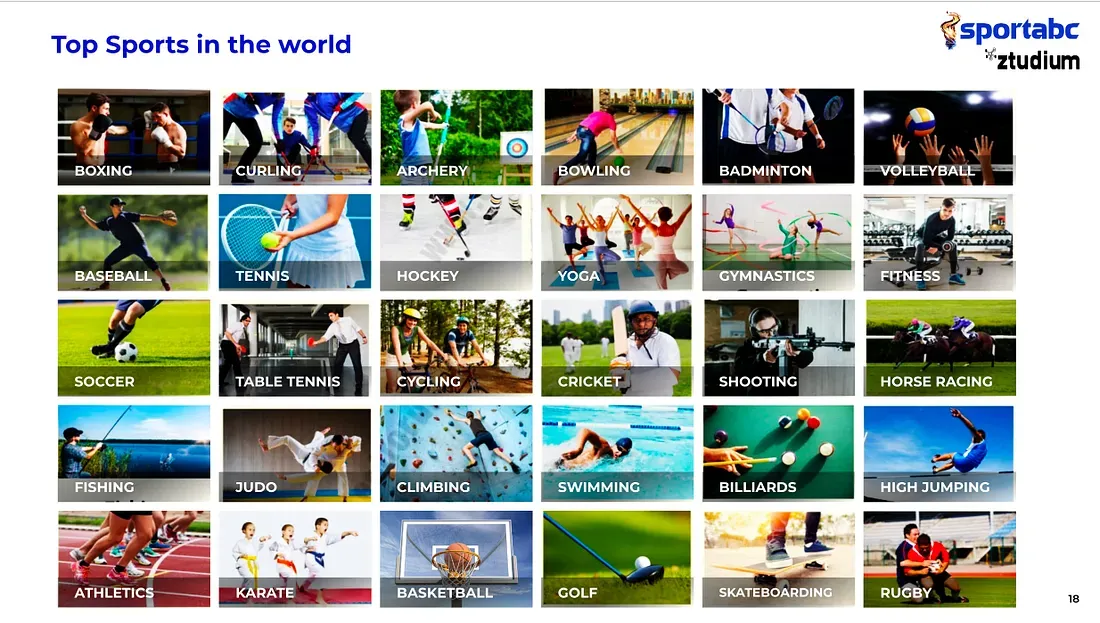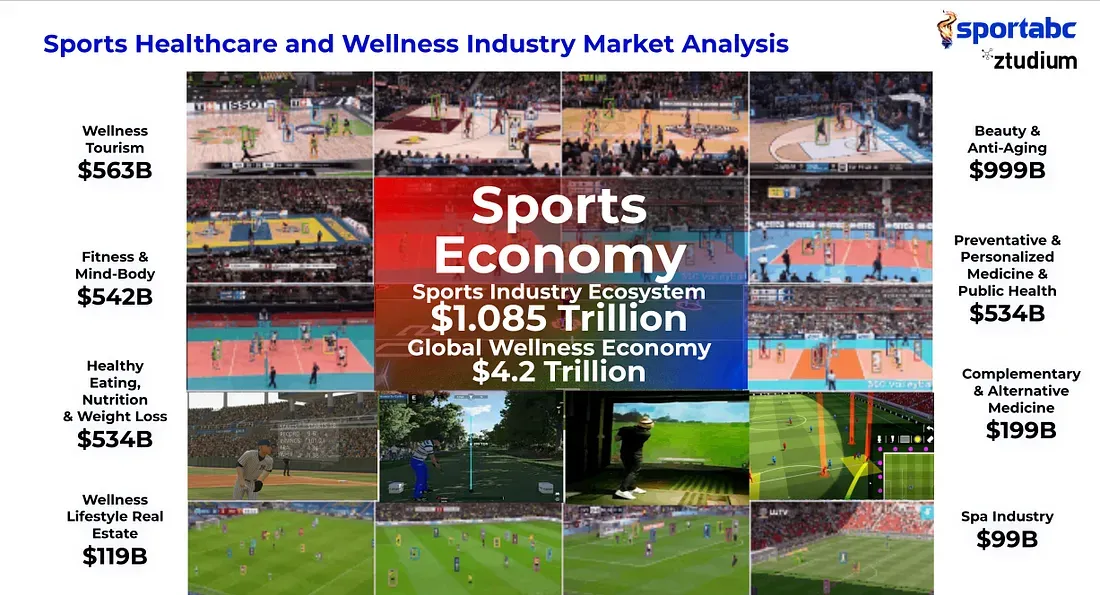business resources
The Sports ABC of Technology: Revolutionising Sports with AI and Smart Innovations
27 Aug 2024, 9:04 am GMT+1
The Sports ABC of Technology, Source Sportsabc, ztudium group
The integration of technology and AI in our lifestyle and society that define sports and wellbeing as the core elements of our life, is the new Sports ABC element. What transformations are shaping the future of sports with AI and smart innovations?
Sports, by their very nature, is simply not a means of expressing our physical prowess. It embodies the essence of human connection and communal spirit, while ensuring the overall wellbeing of individual, as well as the society.
Sports ABC of technology and AI is a comprehensive point-of-view, where Advanced sports analytics, Biometrics and wellbeing, and Computer Vision and spatial physical digital computing, are essentially the building blocks of the human AI coexistence.
As technology becomes a central part of our lives, sports and well-being have increasingly become integral to our daily routines. Especially during the past decade, we have noticed how the integration of technology and AI is transforming these areas, making them a fundamental aspect of modern living.
The integration of Artificial Intelligence (AI) has driven significant transformations, particularly in response to the increasing demand for real-time data analytics, chatbots, and virtual assistants. The global market for AI in sports, valued at $2.2 billion in 2022, is anticipated to surge to $29.7 billion by 2027.
According to Research And Markets, the sports industry grew from $486.61 billion in 2022 to $512.14 billion in 2023, with projections estimating it will reach $623.23 billion by 2027.
As the sports industry grow there are considerations we need to address around the importance of the impact of technology, especially artificial intelligence, in all areas of sports and wellbeing.
The sports and wellbeing economy
As the world becomes increasingly urbanised and technology-driven, the need to maintain physical health and social connection has never been more crucial. The Sports and Wellbeing Economy embodies this dual focus, integrating physical activity, mental health, and community engagement with economic initiatives that create value for individuals and society alike.
The Sports and Wellbeing Economy is a research and society proposal concept that combines the best of the Gig Economy, Creative Economy, Digital Literacy, AI Literacy to empower each of us in a time when technology, robotics and AI are redefining what it means to be human, our work physical and digital bridges.
This concept of Sports and Wellbeing Economy is increasingly more important to balance our physical, digital spatial computing intelligence and to create new economic models that reinvent in a utopian human first vision humanity where we can establish a social economic model that reestablish humans in the increasingly urban society and when economy is and will be increasingly automated.

How Tech and AI in sports is transforming the industry?
The integration of technology into sports is revolutionising every aspect of the industry, from performance enhancement to fan engagement. Here’s a detailed look at how technology is reshaping the sports landscape:
1. Advanced performance analytics
Wearable technology: Athletes now use wearables to track performance metrics such as heart rate, speed, and movement patterns. Devices like GPS trackers and smartwatches provide real-time data, helping coaches tailor training programs to individual needs.
Data analytics: Big data analytics and machine learning algorithms analyse performance data to uncover patterns and insights. This can lead to better strategic decisions and game plans. For instance, football teams use data to study player movements and develop counter-strategies against opponents.
2. Injury prevention and recovery
Predictive analytics: AI models analyse historical injury data and current performance metrics to predict potential injuries. This helps in adjusting training loads to prevent injuries before they occur.
Rehabilitation technologies: Advanced rehabilitation tools, such as robotic exoskeletons and virtual reality (VR) environments, assist athletes in recovery by simulating game conditions and tracking progress.
3. Fan engagement and experience
Augmented Reality (AR) and Virtual Reality (VR): AR and VR offer immersive fan experiences. Fans can use VR to experience games from different angles or AR to access live statistics during a match. This enhances engagement and creates new revenue streams.
Personalised content: AI-driven platforms provide personalised content, such as tailored highlight reels and interactive features based on user preferences and behaviour.
4. Enhanced officiating
Video review systems: Technologies like VAR (Video Assistant Referee) in football and Hawk-Eye in tennis provide accurate and unbiased officiating. These systems review decisions in real time, reducing human error and ensuring fair play.
AI in officiating: AI systems analyse player and ball movements to assist referees in making more precise decisions.
5. Smart stadiums
Internet of Things (IoT): Smart stadiums use IoT devices to enhance the fan experience. For example, sensors monitor crowd movements, manage ticketing and concessions, and optimise stadium operations.
Connected infrastructure: Enhanced connectivity through 5G/6G technology ensures seamless data transmission and improves the overall stadium experience for both in-person and remote fans.
For example, sensors monitor crowd movements, manage ticketing and concessions, event digital signage and optimise stadium operations.
6. Sports media and broadcasting
AI in broadcasting: AI technologies are used to create engaging content, such as automatic highlight generation and real-time match analysis. This technology also helps in managing live broadcasts, ensuring high-quality streams and minimal interruptions.
Blockchain: Blockchain technology is being explored for its potential in secure broadcasting rights management, ticketing, and fan engagement platforms.
7. Esports and gaming
Growth of Esports: The rise of esports has been driven by advancements in gaming technology. High-definition graphics, VR, and AR create immersive gaming experiences that attract millions of viewers and participants worldwide.
AI in gaming: AI enhances gaming experiences through advanced game design, realistic player interactions, and personalised in-game content.
Trends, technology, and economic impacts: Tech and AI in sports
The sports market is a dynamic and expansive industry encompassing a range of sectors, including professional sports, sports media, sports technology, and fan engagement. The integration of technology into sports has been transformative, influencing performance analytics, fan experience, and operational efficiencies.
The global sports market was valued at approximately USD 500 billion in 2023 and is expected to reach around USD 600 billion by 2027, growing at a compound annual growth rate (CAGR) of 4-5%. This growth is driven by increasing sports participation, rising media rights values, and the integration of technology.
North America and Europe are significant markets, with North America leading due to high sports consumption and major sports leagues like the NFL, NBA, and NHL. The Asia-Pacific region is experiencing rapid growth, driven by rising sports viewership and investments in sports infrastructure.

Further, high-profile athletes drive substantial revenue through endorsements and sponsorships, with an estimated market value exceeding USD 10 billion annually. This includes LeBron James’ lifetime deal with Nike, valued at over $1 billion; Cristiano Ronaldo’s endorsement deals with Nike and CR7; tennis legend Roger Federer’s $300 million partnership with Uniqlo; Serena Williams’ endorsements with Nike and Gatorade; and Naomi Osaka's top earning deals with Nike and Mastercard.
According to WIPO, for many sports organisations, such as the International Sports Broadcasting Company, the sale of broadcasting and media rights has become the primary revenue source. This income is crucial for funding major sporting events, renovating stadiums, and supporting grassroots sports development. The royalties broadcasters earn from selling exclusive footage to other media outlets allow them to invest in the expensive organisational and technical infrastructure required to broadcast sports events to millions of fans worldwide.
Streaming services and digital platforms are gaining prominence, offering fans access to live sports content and personalised experiences. The OTT (Over-the-Top) sports streaming market is projected to grow at a CAGR of 12% over the next five years.
The sports apparel market is thriving, with major brands like Nike, Adidas, and Under Armour leading the industry. The market was valued at USD 200 billion in 2023 and is expected to grow at a CAGR of 5% over the next decade.
Here are some technological advancements in sports equipment driving growth in this segment.
- Wearable technology: Wearables provide real-time data on athletes' performance, aiding in training and injury prevention. Devices like smartwatches and fitness trackers are increasingly popular among both professionals and amateurs.
- AI and data analytics: AI and machine learning are used for performance analysis, injury prediction, and strategic planning. AI-driven tools offer insights into player statistics and game tactics, helping teams make data-informed decisions.
- AR and VR: AR and VR technologies offer immersive fan experiences and advanced training simulations. VR allows fans to experience games from various angles, while AR enhances live broadcasts with real-time statistics and interactive elements.
- Blockchain: Blockchain technology is being explored for secure ticketing, rights management, and fan engagement platforms. It provides transparency and security in transactions and digital collectables.
The sports industry supports millions of jobs globally, including roles in coaching, sports management, media, and technology. The rise of esports and digital media is also creating new job opportunities.
Major sporting events drive tourism and local economic activity. Events like the Olympics and FIFA World Cup attract global visitors, generating significant revenue for host cities and countries.
The Sports abc of technology
If we look at multiple sources the sports economy the global sports market was experiencing significant growth. However, this figure may have changed due to various factors, including the impact of global events and the accelerated adoption of technology. Here is what I mean by the Sports ABC of technology:
A. Analytics, data and AI: Advanced sports analytics, data analytics are revolutionising how teams and athletes approach training, strategy, and performance optimisation. Machine learning algorithms are being used to analyze vast amounts of data from wearables, video footage, and historical performance metrics to identify patterns and insights that can give teams a competitive edge.
B. Biometrics and wellbeing: Wearable technology and biometric sensors are providing real-time data on athletes’ physiological states and improving and changing their wellbeing. This includes heart rate, muscle activation, sleep patterns, and more. This data is crucial for personalising training regimens and preventing injuries.
C. Computer Vision and spatial physical digital computing: AI-powered computer vision systems are being used for various applications, including:
Automated video analysis for tactical insights
Real-time player tracking
Assist in officiating decisions (e.g., goal-line technology in soccer)
Share this
Dinis Guarda
Author
Dinis Guarda is an author, entrepreneur, founder CEO of ztudium, Businessabc, citiesabc.com and Wisdomia.ai. Dinis is an AI leader, researcher and creator who has been building proprietary solutions based on technologies like digital twins, 3D, spatial computing, AR/VR/MR. Dinis is also an author of multiple books, including "4IR AI Blockchain Fintech IoT Reinventing a Nation" and others. Dinis has been collaborating with the likes of UN / UNITAR, UNESCO, European Space Agency, IBM, Siemens, Mastercard, and governments like USAID, and Malaysia Government to mention a few. He has been a guest lecturer at business schools such as Copenhagen Business School. Dinis is ranked as one of the most influential people and thought leaders in Thinkers360 / Rise Global’s The Artificial Intelligence Power 100, Top 10 Thought leaders in AI, smart cities, metaverse, blockchain, fintech.
previous
Top Business Briefcases for Great First Impressions
next
How to Choose the Best Residential Carpet Cleaning Company